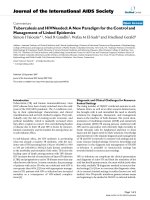143 new asylum countries migration control and refugee protection in an enlarged european union immigration and asylum law and policy in europe 4 imm
Bạn đang xem bản rút gọn của tài liệu. Xem và tải ngay bản đầy đủ của tài liệu tại đây (21.79 MB, 486 trang )
NEW ASYLUM COUNTRIES?
IMMIGRATION AND ASYLUM LAW AND POLICY IN EUROPE
Volume 4
Editors
Elspeth Guild
Kingsley Napley Solicitors, London,
Centre for Migration Law, Katholieke Universiteit, Nijmegen
Jan Niessen
Migration Policy Group, Brussels
The series is a venue for books on European immigration and asylum law and
policies where academics, policy makers, law practitioners and others look to find
detailed analysis of this dynamic field. Works in the series will start from a
European perspective. The increased co-operation within the European Union and
the Council of Europe on matters related to immigration and asylum requires the
publication of theoretical and empirical research. The series will contribute to
well-informed policy debates by analysing and interpreting the evolving European
legislation and its effects on national law and policies. The series brings together
the various stakeholders in these policy debates: the legal profession, researchers,
employers, trade unions, human rights and other civil society organisations.
The titles publised in this series are listed at the end of this volume.
New Asylum Countries?
Migration Control and Refugee Protection
in an Enlarged European Union
Edited by
ROSEMARY BYRNE
Lecturer,
Trinity College,
Dublin, Ireland
GREGOR NOLL
Research Director,
Danish Centre for Human Rights,
Copenhagen, Denmark
and
JENS VEDSTED-HANSEN
Professor,
University ofAarhus Law School, Denmark
KLUWER LAW INTERNATIONAL
THE HAGUE / LONDON / NEW YORK
A C.I.P. Catalogue record for this book is available from the Library of Congress.
ISBN 90-411-1753-9
Published by Kluwer Law International,
P.O. Box 85889, 2508 CN The Hague, The Netherlands.
Sold and distributed in North, Central and South America
by Kluwer Law International,
101 Philip Drive, Norwell, MA 02061, U.S.A.
kluwerlaw @ wkap.com
In all other countries, sold and distributed
by Kluwer Law International, Distribution Centre,
P.O. Box 322, 3300 AH Dordrecht, The Netherlands.
Printed on acid-free paper
All Rights Reserved
© 2002 Kluwer Law International
Kluwer Law International incorporates the publishing programmes of
Graham & Trotman Ltd, Kluwer Law and Taxation Publishers,
and Martinus Nijhoff Publishers.
No part of the material protected by this copyright notice may be reproduced or
utilized in any form or by any means, electronic or mechanical,
including photocopying, recording or by any information storage and
retrieval system, without written permission from the copyright owner.
Printed in the Netherlands.
Table of Contents
TABLE OF CONTENTS
V
LIST OF FIGURES AND TABLES
XVI
ABBREVIATIONS
XIX
INTRODUCTION
1
1 WESTERN EUROPEAN ASYLUM POLICIES FOR
EXPORT: THE TRANSFER OF PROTECTION AND
DEFLECTION FORMULAS TO CENTRAL EUROPE AND
THE BALTICS
5
1.I The EU Accession Process
1.ll Non-Admission and Non-Arrival Policies
5
10
1.II.A Various Types of Deflection of Asylum
Seekers
10
l.ll.B
Deflection Policies with a Particular Impact
on Central European States
14
1.II.C Shifting Responsibility and Creating Safe
Third Countries
16
1.lll Safe Third Country Practices
17
l.lll.A The Notion of a Safe Third Country
1.lll.B The Dublin Convention and EU Member
States as Safe Third Countries
1.lll.C Harmonization and Safe Third Country
Practices
1.lll.D Accession, Enlargement and Safe Third
Country Practices
17
19
21
25
1.1V Reshuffling Protection Burdens
28
2 THE CENTRAL LINK: GERMANY, POLAND AND THE
CZECH REPUBLIC
29
2.I
Germany
29
V
TABLE OF CONTENTS
2.I.A
2.I.B
Policy
Practices
29
31
2.I.A.I The Domestic Legal Framework
33
2.I.A. l.(a) The German concept of safe third countries
33
2.l.A.1.(b) Entry and apprehension in the border zone
38
2.I.A.1.(c) In-country application
40
2.I.A.2 Negotiating the Eastern Border
41
2.I.A.2 (a) Poland
42
2.I.A.2 (b) The Czech Republic
44
2.I.C
2.II
Conclusion
Poland
2.II.1
General Situation and Policy
2.II.A.I. Conversion from Sending Country to Transit
2.II.A.2 Migratory Pressure from the East and South
2.II.A.3 Pressure from the West
2.II.A.3 (a)Financing and co-operation
2.II.A.3 (b)The political aspect
2.II.A.4 Readmission Agreements with the Eastern
Neighbours
2.II.B
Changes in the Law
2.II.B.I Fundamental Steps
2.II.B. 1 (a) Refugee status and asylum
2.II.B. 1 (b) Bodies deciding in refugee matters
2.II.B.2 Access to the Determination Procedure
2.II.B.3 The Notion of 'Safe Country'
2.II.B.3 (a) Definitions
2.II.B.3 (b) Practice
2.II.B.4 Detention
2.II.B.5 Humanitarian Status (Temporary Protection)
2.II.C
Conclusions
2.Ill The Czech Republic
2.III.A Transit or Destination State?
2.III.A.I Political Concerns
2.III.A.2 Rising Numbers of Asylum Seekers
2.III.A.3 Implementing Readmission Agreements with
Neighbouring States
VI
46
48
48
48
53
56
56
59
60
62
62
64
64
66
68
68
70
71
73
75
78
78
78
78
79
TABLE OF CONTENTS
2 . / / / . B Legislative Practices
81
2.III.B.I The Aliens Act
81
2.III.B.2 The Asylum Act
85
2.III.B.3 Multifunctional Character of the Asylum Act
85
2.III.B.4 A Comparison of the Asylum Act and the Charter
of Fundamental Rights and Freedoms
85
2.III.B.5 The Concept of the Safe Country of Origin
87
2.III.B.6 The Concept of the Safe Third Country
88
2.III.B.7 The Concept of Persecution
89
2.III.B.8 The Entry of an Applicant into the Territory and
the Institution of Asylum Procedure
89
2.III.B.9 Appeal Options
91
2.III.B.10 Manifestly Unfounded Applications
91
2.III.B.11 Minimum Procedural Guarantees
92
2.///.C
2.IV
Conclusion
92
Conclusions on the Central Link
94
2.IV.A The Proliferation of Strategies and CounterStrategies
94
2.IV.B Numbers
95
2.IV.C The New Orbiters
96
3 THE SOUTHERN LINK: AUSTRIA AND HUNGARY 100
3.I Austria
100
3.I.A
Introduction
100
3.I.B
Developments in Domestic Legislation 101
3.I.B.1
Amendments in 1990 Justified as 'Emergency
Responses'
101
3.I.B.2 The Phase of Consolidated Restrictionism
104
3.I.B.3
Relaxing Restrictionism: 1997 and Beyond
107
3./.C
Building a New Curtain
1 10
3.I.C.I The Multilateral Dimension
110
3./.C. 1 (a) EU membership
1 10
3.I.C.1 (b) Schengen
11 1
3.I.C.2 The Bilateral Dimensions
113
3.I.C.2 (a) Border control and apprehension in the
border zone
1 13
3.I.C.2(b) Readmission agreements
1 16
3.I.D
Transposing the Acquis
119
vii
TABLE OF CONTENTS
3.I.D.1 The Safe Third Country Concept
119
3.I.D.2 Implementation of the Dublin Convention
127
3.I.D.3 Manifestly Unfounded Cases and Accelerated
Procedures
128
3.I.D.4 Airport Transit and Applications for Asylum at the
Airports
129
3.I.D.5 Carrier Sanctions
131
3.I.D.6 Applications at the Borders
131
3.I.E
Austrian Policies Targeting Hungary
3.I.E.I
3.I.E.2
Zone
3.I.E.4
132
Hungary as a Safe Third Country
132
Border Control and Apprehension in the Border
135
Austria's Capacity-building Measures in Hungary
137
3.II Hungary
138
3.II.A Introduction: Notes on the History of
Migratory Movements in Hungary
138
3.II.B
Challenges Shaping Hungary's Role and
Policy over the Last Decade
140
3.II.B.1 The General Pressure of Migrants
140
3.II.B.2 Hungary as a Country of Asylum
1 46
3.//.B.2 (a) The first phase
147
3.//.B.2 (bj The second phase
149
3.//.B.2 (c) The third phase
150
3.//.B.2 (d)Role of the UNHCR until 1998
151
3.I/.B.2 (e) The fourth phase
152
3.//.B.2 (f) Problems with the data (where have all the
new arrivals gone?)
155
3.II.C
The Challenge Posed by the EU
3.II.C.I
3.II.C.2
3.//.D
The Practice in its Changing Form
3.II.D.1
Western
3.II.D.2
3.II.D.3
158
Bordering Austria and the European Union
158
Legal and Policy Harmonization with the EU 159
161
Impact of Non-Domestic Actors Including
European States and the EU
1 62
The Effect of Bilateral Treaties
1 67
Unique Features of Hungarian Law and Practice
176
3.II.D.3 (a)The road to the new act
177
viii
TABLE OF CONTENTS
3.//.D.3 (b)Critical elements of the new Hungarian
legislation concerning asylum seekers and refugees
178
3.II.D.3 (c)The 2001 bill: the EU acquis as a pretext or a
guiding tool?
194
3.II.E
Conclusion
197
3.Ill Concluding Observations on the Southern Link
200
4 THE NORTHERN LINK
203
4.1 Nordic Policy Responses to the Baltic Asylum
Challenge
203
4. LA
Strategic Aspects of the Nordic-Baltic
Relationship
203
4.I.A.1 Diverging Interests: Political Support vs. SelfProtection
203
4.I.A.2 Safe Third Country Criteria and the Ensuing
Containment Policy
205
4.I.A.3 The Episodic Approach to Policy-making
208
4.I.B
Political Self-Interests and Dependencies
21 1
4.I.B.1
Conditionality in Migration Policies
211
4.I.B.2 Abolition of the Visa Regime
213
4.I.B.3 From Sub-regional Conditionality to EU Accession
Pressures
216
4.I.C
Cooperation and Coordination on Asylum
and Migration Issues
218
4.I.C.1 Cooperation Forums and Division of
Responsibilities
218
4.I.C.2 Influential Cooperation: Containment and
Capacity-building
220
4.1.D
Protection vs. Exclusion as the Objective of
Cooperation
222
4.II Lithuania
226
4.II.A
Factors which Prompted Establishment of
Asylum Systems
226
4.2.A.1
Background and Context
226
4.II.A.2 Trading Rights with Nordic States: Visa-free Travel
and Refugee Protection
228
ix
TABLE OF CONTENTS
4.II.A.3
Pressure from International Organizations
230
4.II.B Legislative Practice: Balancing Refugee
Protection against Exclusion
231
4.II.B.1
Access to the Territory
231
4.II.B.2 Access to the Procedures
235
4.//.B.2 (a) At the border
235
4.I/.B.2 (b) In the territory
235
4.I/.8.2 (c) On readmission from the West
238
4.II.B.3
Refugee Definition
239
4.//.B.3 (a) Existing definition
239
4.//.B.3 (b) Exclusion clauses
243
4.II.B.4 Asylum Procedures
245
4.//.B.4 (aj Time-limit clauses for asylum applications245
4.//.B.4. (b) Appeal rights and suspending effect 246
4.//.B.4 (c) Accelerated procedures
248
4.II.B.4. (d) Detention of asylum seekers: general rule
or exception?
249
4.II.B.5 Cases Falling Outside the Existing Refugee
Definition
253
4.//.B.5 (a) Lack of alternafive status and efforts
towards introducing one
253
4.II.B.5 (b) Fate of persons excluded from the existing
refugee definition
254
4.II.B.6 Restrictive Practices
258
4.//.C
Policy Strategies
4.II.C.I
4.II.C.2
4.II.C.3
Concerns for Stability
Avoiding the 'Closed-Sack' Effect
Adopting Western Practices
259
259
260
265
4.Ill Latvia
267
4 . I I I . A Factors which Prompted Establishment of
the Asylum System
267
4.III.A.I Background and Context
267
4.III.A.2 Trading Rights with Nordic States: Visa-free Travel
and Asylum Protection
270
4.III.A.3 Pressure from International Organizations
271
4.///.B Legislative Practice: Balancing Refugee
Protection against Exclusion
272
4.III.B.I
4.III.B.2
X
Access to Territory
Access to Procedures
272
273
TABLE OF CONTENTS
4.III.B.2 (a) At the border
273
4.III.B.2 (b) In the territory
274
4.III.B.3 Refugee Definition
274
4.///.B.3 (a) Existing definition
274
4.III.B.3 (b)
Exclusion clauses
275
4.III.B.4 Asylum Procedures
276
4.III.B.4 (a) First instance level
276
4.III.B.4 (b) Second instance
276
4.III.B.4 (c) Accelerated procedures
277
4.III.B.5 Caseload Falling Outside the Existing Definition
277
4.///.B.5 (a) Lack of alternative status
277
4.III.B.5 (b) Deportation
278
4.III.C
Capacity Building
278
4.III.C.I Reception and Asylum Systems
4.III.C.2 Strengthening Border Controls
278
279
4 IV Estonia
281
4.IV.A Factors which Prompted the Establishment
of Asylum Systems
281
4.IV.A.I Background and Context
4.IV.A.2 Trading Rights with Nordic States: Visa-free
Travel and Asylum Protection
4.IV.A.3 Pressure from International Organisations
281
283
284
4.IV.B Legislative Practices: Balancing Refugee
Protection against Exclusion
286
4.IV.B.I Access to Territory
287
4.IV.B.2 Access to Procedures
287
4.IV.B.2 (a) At the border
287
4.IV.B.2 (b) In the territory
290
4.IV.B.2 (c) Upon readmission from the west
290
4.IV.B.3 Refugee Definition
291
4.IV.B.4 Asylum Procedures
292
4.IV.B.4 (a) Time-limit clauses for asylum applications
292
4.IV.B.4 (b) Appeal rights and suspensive effect
292
4.IV.B.4 (c) Accelerated procedures
294
4.IV.B.4 (d) Detention of asylum seekers
296
4.IV.B.5 Caseload Falling outside the Existing Definition
297
xi
TABLE OF CONTENTS
4./V.B.5 (a) Lack of alternative status
297
4.IV.B.5 (b) Fate of those persons outside of the
definition
297
4./V.C Policy Strategies
298
4.IV.C.I Policies of Evasion: Fear of 'Closed-Sack' Effect
298
4.IV.C.2 Transposing Western Practices
299
4.V Concluding Observations on the Northern Link
301
5
PROTECTION IN A SPIRIT OF SOLIDARITY?
305
5.1 The Role of Burden-Sharing in the Enlargement
Context
305
5.LA
The Objective of Burden-sharing
5.I.B
The Scope of Burden-sharing
5.1.B.I Sharing Norms
5.I.B.2 Sharing Money
5.I.B.3 Sharing People
306
307
31 1
312
313
5.11 A Synopsis of Burden-Sharing in the EU Context
313
5.II.A
Bosnia and Kosovo as Problem Indicators
313
5.II.B Standard-Setting and Regime-Building
Efforts in the EU
314
5.Ill Burden-Concentration in Europe
5.III.A Jhe Dublin Convention
5.III.B Safe Third Countries in the East
5.1V Conclusions
319
319
321
324
6 TITLE IV TEC AND THE SCHENGEN INTEGRATION
PROTOCOL WITH SPECIAL REGARD TO
IMPLICATIONS ON ACCESSION CANDIDATES
325
6.1. Introduction
325
6.II.A New Areas of Jurisdiction in Title IV of the TEC;
the Third Pillar Acquis in the Fields of Asylum and
Refugee Law to be Implemented in the First Pillar 328
xii
TABLE OF CONTENTS
6.//.B Forms of Legal Action; Possibilities of
Incorporating the Acquis to Date into Community
Law
336
6.II.C Jurisdictions of the ECJ
34 1
6.//.D
Implications for Accession Candidates 341
6.II.E
The Schengen Protocol; Incorporating the
Schengen Acquis into Community or Union Law345
6.II.F
Issues of Transparency
348
6.//.G The Asylum Protocol
350
6.Ill Resume
350
7 RECENT DEVELOPMENTS IN CENTRAL EUROPE
AND THE BALTIC STATES IN THE ASYLUM FIELD: A
VIEW FROM UNHCR AND THE STRATEGIES OF THE
HIGH COMMISSIONER FOR ENHANCING THE ASYLUM
SYSTEMS OF THE REGION
351
7.1 Introduction
351
7.11 Recent Developments in the Central European
and Baltic States
352
7.II.A
Important Achievements in Building Asylum
Systems
352
7.II.B
The Forces Driving Progress
352
7.II.C Some Problems Still to be Overcome
353
7.II.D
Prevention of Illegal Migration and
Refugee Protection
354
7.Ill UNHCR's Objectives and Strategies in Central
Europe and the Baltic States
356
7.III.A How to Proceed in the New Asylum
Countries?
356
7.III.B The Prime Objectives of UNHCR in the CEBS
356
7.III.C UNHCR's Main Activities in the Region 358
7.1V EU Involvement in Institution and Capacity
Building in the Central European and Baltic States
359
XIII
TABLE OF CONTENTS
7.V EU Harmonization and the EU Acquis on Asylum:
UNHCR's Perspective on the Implications for the
Central European and Baltic States
360
7.V.A UNHCR's View of the EU Harmonization
Process
360
7.V.B The EU Acquis as an Asset for Refugee
Protection in the CEBS
362
7.V.C The EU Acquis on Asylum and International
Refugee Law Standards
362
7.VI Assessing the Results of UNHCR's Strategy
366
7.VII An Attempt to Predict the Future
368
7. VII.A The Continued Momentum Created by EU
Accession
368
7.VII.B Some Problems that may Persist
370
7.V//.C Future UNHCR Activities in the Region 371
8 FUTURE PERSPECTIVES: ACCESSION AND ASYLUM
IN AN EXPANDED EUROPEAN UNION
373
8.I Introduction
373
8.II Migration and Asylum Policy in the West in the
1990s
378
8.Ill Factoring the Influences on Asylum Policy: the
Accession Process in Context
381
8.III.A Chain Reactions: Readmission Agreements,
'Safe Third Country' Policies and the 'Closed
Sack' Fear
383
8.III.B Transferring the Acquis and the
Democratic Process
391
8.1V The Process of Accession
396
8.V The Tampere Summit and the Future of the
Asylum Acquis
399
8.VI Transposing the Acquis
402
8.V/.A Manifestly Unfounded Claims
403
8.VI.B Minimum Guarantees for Asylum
Procedures
408
xiv
TABLE OF CONTENTS
8.V/.C Bifurcated Harmonization: Procedure
Before Substance
412
8.VI.D Judicial Chalienges to the Presumption of
Equal Justice
4 16
8.VII Lessons Learned
421
9 TRANSFORMATION OF ASYLUM IN EUROPE
423
9.I
and
9.II
9.Ill
A Comparative Assessment of Migration Control
Refugee Protection in the Three Sub-regions 424
The Phases of the Transformation of Asylum 426
Asylum and Enlargement
429
SELECT BIBLIOGRAPHY
433
LIST OF CONTRIBUTORS
439
INDEX
443
xv
List of Figures and Tables
Figure 1:
1998 Monthly Asylum Applications
264
Figure 2:
Tendencies in Asylum Applications during the four
years since the Asylum Procedure became
operational in Lithuania (1997-2000)
264
Figure 3:
Subregional Transformation Processes
Table 1:
Total Applications for Refugee Status or Asylum
1994-2000
50
Table 2:
Top Ten Countries of Origin for Refugee Status or
Asylum Applicants in Poland in 1998
51
Table 3:
Significant Changes in Application Totals
1999-2000
424
52
Table 4:
First Instance Positive Decisions for Refugee
Status Grantees in 2000
54
Table 5:
Austrian Asylum Applications, Recognition Rates
and Positive Decisions 1990-1997
107
Table 6:
Arrests by the Border Guard for Illegal Border
Crossings 1991-2000
142
Table 7:
Combined Border Crossing Statistics 1991-2000
143
Table 8:
Total Denial of Entries (Return at the Border)
1991-2000
144
Table 9:
Expulsion Orders Issued by the Border Guard by
Country of Origin 1995-2000
145
Table 10: Criminal Law Proceedings Initiated against
Suspects in Human Trafficking
146
Table 11: The Number of Asylum Seekers in the First Wave
148
Table 12: The Number of Aslum Seekers in the Second Wave
150
xvi
FIGURES AND TABLES
Table 13: The Third Phase in Hungary's Reception of Asylum
Seekers
151
Table 14: The Role of UNHCR until 1998
152
Table 15: The Fourth Phase in Hungarian Inflow and
Reception of Asylum Seekers
154
Table 16: Outcome for New Arrivals Between 1987-1997
156
Table 17: Re-Admission Agreements Concluded by Hungary
in the order of their Entry into Force as of 1
January 2001
168
Table 18: Persons Re-Admitted and Returned to
Neighbouring Countries under Re-Admission
Agreements in 1998-2000
172
Table 19: Re-Admissions from Austria within the
Competence of the Gyor Border Guard Directorate
173
Table 20: Breakdown of Re-Admitted Persons by the
Nationalities with at least 10 persons
174
Table 21: Number of Refugees Receiving Some Form of
Protection in 1999-2000
182
Table 22: Irregular Immigrants Detained in Lithuania
227
Table 23: Migration Department's Application of Article 4
1997-2000
237
Table 24: 2000 Lithuanian refugee applications
257
Table 25: Asylum Applications from Persons Readmitted
from Poland
262
Table 26: Asylum Applications 1997 and 1998
265
xvii
This page intentionally left blank
ABBREVIATIONS
Abbreviations
CAT
Convention Against Torture
CCP
Polish Code of Civil Procedure
CEBS
Central European and Baltic States
DC
Dublin Convention
EA
European Agreement
ECHR
Convention for
Human
Rights
Freedoms
ECtHR
European Court of Human Rights
ECJ
European Court of Justice
EFTA
European Free Trade Agreement
ERF
European Refugee Fund
EU
European Union
ICCPR
International Covenant on Civil and
Political Rights
MIAA
Polish Minister of Internal A f f a i r s and
Administration
NIP
National Initiative Programme
NPAA
National Plan for the Adoption of the
Acquis
NSHF
Nordic Joint Advisory Group of Senior
Officials
OJ
Official Journal of the European
Communities
PHP
P H A R E Horizontal Programme for
Justice and Home Affairs
PHPA
PHARE Horizontal Programme on
Asylum
Refugee
Convention
Convention Relating to the Status of
Refugees
the
and
Protection of
Fundamental
xix
ABBREVIATIONS
TEC
TEU
xx
Refugees
Treaty Establishing the European
Community
Treaty Establishing the European
Union
introduction
Have the Baltic and Central European States turned into the asylum
backyard of the European Union? If this is the case, is Brussels to
blame, or individual Member States, or even candidate countries
applying for membership in the EU? What does this mean for the
integrity of the protection system as it has evolved over the past fifty
years? And what does this imply in the future for individuals seeking
protection in an enlarged EU?
This book is about the transformation of asylum in Europe in the context
of the enlargement of the EU, and the ways it is affected by the
tension between protection interests and the interests of migration
control. This transformation involves norms, as well as procedures
and resources for their implementation.
Apart from asking what the elements of this transformation process
are, we shall also analyse how this transformation is taking place. In so
doing, we shall engage in an analysis of three distinct and
interdependent levels of law and policy: the domestic level, the subregional level, and the regional level. The domestic level is about how
asylum and migration law is formulated by the electorate and legislator
of a specific state. The sub-regional level is about how neighbouring
countries (e.g., Austria and Hungary) impact each other in the shaping
of law and policy. The regional level deals with the accession of
present candidate countries to the Union, and their duty to implement
the acquis communautaire. We shall also ask when transformation is taking
place, and attempt to identify and delimit critical phases in the overall
process.
Finally, what does the transformation process tell us about the current
EU asylum acquis, and what does it tell us about the prospects for
protection in the new frontier states and beyond?
This background of current European developments will be analysed
more generally in Chapter 1. In the ensuing chapters, central problems
regarding protection within the presently functioning system in
Europe will be studied under a structure of sub-regional description
and analysis: The central link (Germany, Poland, and the Czech
Republic) will be dealt with in Chapter 2; the southern link (Austria
and Hungary) in Chapter 3; and the northern link (the four Nordic and
the three Baltic states) in Chapter 4. Concluding observations will be
presented at the end of these Chapters as a basis for further discussion
and analysis. It appears that problems of asylum law and practice
1
R. Byrne et a/, (eds.), New Asylum Countries?, 1-3.
© 2002 Kluwer Law International. Printed in the Netherlands.
INTRODUCTION
differ considerably, due to the differences in geographical location,
political situations, and legal traditions between the three sub-regions.
Given that burden-sharing, understood as the actual distribution of
protection obligations, has been and will be the key to comprehending
systems of refugee protection, we shall proceed by presenting various
issues of solidarity and distribution of burdens. Thus, Chapter 5
analyses the EU acquis on burden-sharing, including the provisions in
the Amsterdam Treaty, and reviews the concentration of burdens
caused by the Dublin Convention and other safe third countrymechanisms.
More generally, the Treaty of Amsterdam provides the framework for
regulatory and institutional reform of the EU, with a significant
impact on those policy issues pertaining to asylum and immigration.
This Treaty, and more particularly the provisions therein adopted as
Title IV of the Treaty on European Communities, is further examined
in Chapter 6.
Chapters 7 and 8 analyse a variety of more concrete aspects of the EU
accession process. While Chapter 7 provides an overview of current
protection problems in Central and Eastern European countries, and
discusses strategies for enhanced refugee protection in this region
from a UNHCR perspective, Chapter 8 analyses the future prospects
of the enlargement process. An important finding in this context is
that major elements of the EU asylum acquis, as well as its underlying
policy assumptions, is being tested through the process of adaptation
already taking place in the candidate countries. The experiences gained
in these states should therefore inform the entire process of preparing
new regulatory measures under the reformed system of EU
competences. Finally, Chapter 9 shall summarize the findings of our
inquiry into the transformation of asylum in an enlarged EU.
This book has come to be the result of a three year study drawing on
the expertise of academics and practitioners in candidate countries and
current Member States, as well as individuals from international and
non-governmental organizations, to explore the complex evolution of
refugee policy and practice in a changing Europe. We would like to
express our sincere gratitude for the financial support from the
Danish Social Science Research Council, from UNHCR and from the
University of Aarhus Law School, as well as for the facilities provided
by the Danish Centre for Human Rights, all of which contributed to
the research network's realization of Jens Vedsted-Hansen's initial
project proposal. Furthermore, the substantial input from Martin
Isenbecker, Nina Lassen and Vladimiras Siniovas is gratefully
2
INTRODUCTION
acknowledged. We would also like to thank Christopher Cassetta and
Brenda Porstner for their editorial and layout assistance.
The analysis in this book is based on the law as it stands by January
2001.
It is our hope that this project will contribute to the understanding of
the dynamics of regional and sub-regional law and policy shaping the
future of refugee protection in Europe.
Rosemary Byrne
Gregor Noll
Jens Vedsted-Hansen
3
This page intentionally left blank









